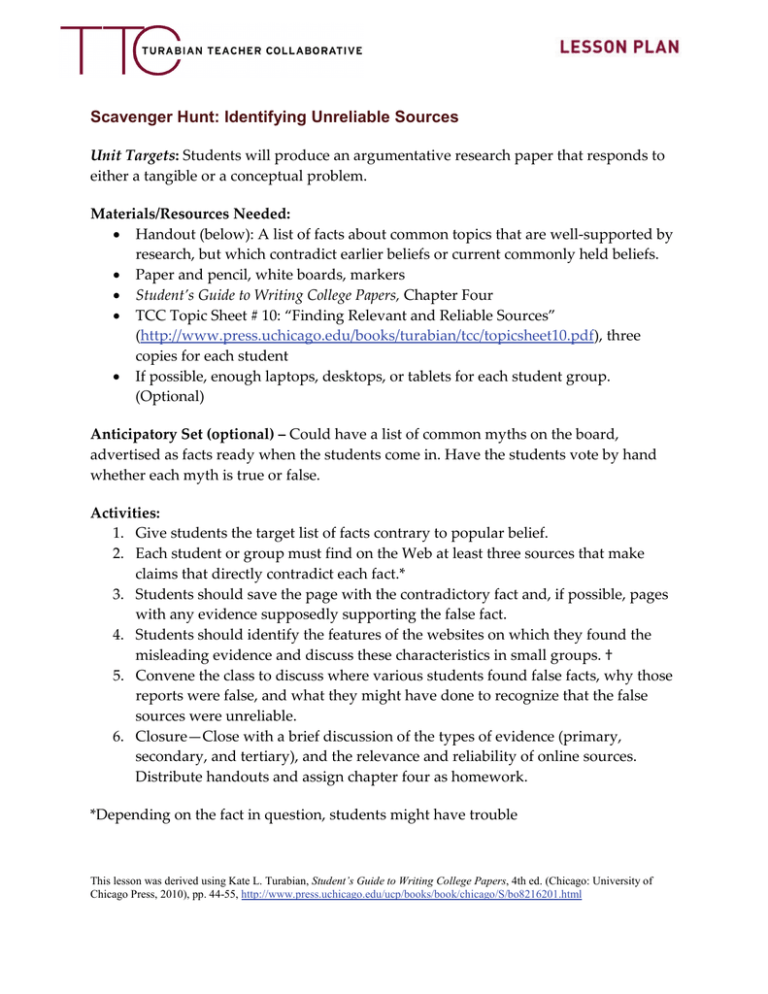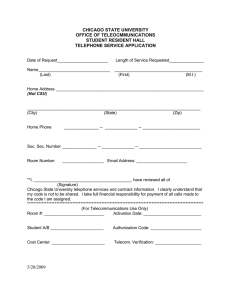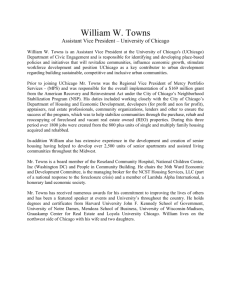Scavenger Hunt: Identifying Unreliable Sources
advertisement

Scavenger Hunt: Identifying Unreliable Sources Unit Targets: Students will produce an argumentative research paper that responds to either a tangible or a conceptual problem. Materials/Resources Needed: • Handout (below): A list of facts about common topics that are well-supported by research, but which contradict earlier beliefs or current commonly held beliefs. • Paper and pencil, white boards, markers • Student’s Guide to Writing College Papers, Chapter Four • TCC Topic Sheet # 10: “Finding Relevant and Reliable Sources” (http://www.press.uchicago.edu/books/turabian/tcc/topicsheet10.pdf), three copies for each student • If possible, enough laptops, desktops, or tablets for each student group. (Optional) Anticipatory Set (optional) – Could have a list of common myths on the board, advertised as facts ready when the students come in. Have the students vote by hand whether each myth is true or false. Activities: 1. Give students the target list of facts contrary to popular belief. 2. Each student or group must find on the Web at least three sources that make claims that directly contradict each fact.* 3. Students should save the page with the contradictory fact and, if possible, pages with any evidence supposedly supporting the false fact. 4. Students should identify the features of the websites on which they found the misleading evidence and discuss these characteristics in small groups. † 5. Convene the class to discuss where various students found false facts, why those reports were false, and what they might have done to recognize that the false sources were unreliable. 6. Closure—Close with a brief discussion of the types of evidence (primary, secondary, and tertiary), and the relevance and reliability of online sources. Distribute handouts and assign chapter four as homework. *Depending on the fact in question, students might have trouble This lesson was derived using Kate L. Turabian, Student’s Guide to Writing College Papers, 4th ed. (Chicago: University of Chicago Press, 2010), pp. 44-55, http://www.press.uchicago.edu/ucp/books/book/chicago/S/bo8216201.html † Optional alternative: If you have computers in class, offer prizes to the first five students who find three bad sources for each fact. Go over the characteristics of the websites with misleading evidence together as a class, after the race. Independent Practice: Have students read chapter four of Student’s Guide. As homework, they have to use the TCC Topic sheet #10 to evaluate at least three online sources. You can also assign “Source Hunt” as a follow-up activity to help students practice their fact-checking. (http://press.uchicago.edu/books/turabian/student/Source_Hunt.pdf) Objective/Purpose: This scavenger hunt would function well early on in the research semester. It helps students to recognize that they must evaluate Web sources carefully. It can also prepare them to learn about warrant and to anticipate objections to arguments in the future. Illinois Common Core ELA: • CCSS.ELA-Literacy.W.11-12.1 Write arguments to support claims in an analysis of substantive topics or texts, using valid reasoning and relevant and sufficient evidence. • CCSS.ELA-Literacy.W.11-12.8 Gather relevant information from multiple authoritative print and digital sources, using advanced searches effectively; assess the strengths and limitations of each source in terms of the task, purpose, and audience; integrate information into the text selectively to maintain the flow of ideas, avoiding plagiarism and overreliance on any one source and following a standard format for citation. • CCSS.ELA-Literacy.W.11-12.9 Draw evidence from literary or informational texts to support analysis, reflection, and research. NCTE Standards 6-8: • Students apply knowledge of language structure, language conventions (e.g., spelling and punctuation), media techniques, figurative language, and genre to create, critique, and discuss print and non-print texts. (6) • Students conduct research on issues and interests by generating ideas and questions, and by posing problems. They gather, evaluate, and synthesize data from a variety of sources (e.g., print and non-print texts, artifacts, people) to communicate their discoveries in ways that suit their purpose and audience. (7) This lesson was derived using Kate L. Turabian, Student’s Guide to Writing College Papers, 4th ed. (Chicago: University of Chicago Press, 2010), pp. 44-55, http://www.press.uchicago.edu/ucp/books/book/chicago/S/bo8216201.html • Students use a variety of technological and information resources (e.g., libraries, databases, computer networks, video) to gather and synthesize information and to create and communicate knowledge. (8) Handout: Contrary to popular belief… Find three web sources that contradict each of these (true!) facts. Save the URL for each website you find, and explain in your notes how the information was false or misleading. Take note of any distinguishing features of the web source (e.g. font, format, citation style, tone, graphics, etc.). Cleopatra was of Macedonian (not Egyptian) descent. Vikings didn’t wear horned helmets. The tallest mountain in the world is Mauna Kea in Hawaii (not Mount Everest). Bulls are color-blind. Polar bears are not left-handed. This lesson was derived using Kate L. Turabian, Student’s Guide to Writing College Papers, 4th ed. (Chicago: University of Chicago Press, 2010), pp. 44-55, http://www.press.uchicago.edu/ucp/books/book/chicago/S/bo8216201.html



